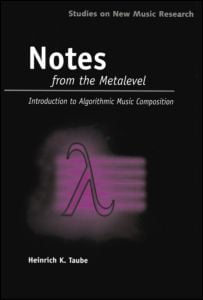
menu
a4dvtm
clipsafe
Old-Time Music
Gamelan
New Music America 1986
'Zines of the 1980s
Taoist Farmer 道人
| | Resources | Configuration | CM Pocket Ref | |
Computer Aided Composition (CAC) is not "Computer Music". What the Word Processor is to the writer, CAC is to the composer.
| scale: | micro |
| process-time: | non-real-time |
| idiom-affinity: | plural |
| extensibility: | open |
| event production: | generative |
| sound source: | all |
| user environment: | textual language |
The paper Navigating the Landscape of Computer Aided Algorithmic Composition Systems, by Christopher Ariza, is an excellent resource and describes how to filter within the algorithmic.net website based on seven system descriptors. The system filters I used to validate my decision to use Common Music were:




Common Music was written by Heinrich Taube beginning in 1989 while at CCRMA and later at Zentrum für Kunst und Medientechnologie Karlsruhe. Common Music is a composition language written on top of the Lisp programming language.
The Common Music email list is a good place for current information.
Taube, Heinrich. 1997. An Introduction to Common Music. Computer Music Journal 21 (1):29-34.
Notes from the Metalevel: An Introduction to Computer Composition, by Heinrich Taube, (CMJ Review)was published in 2004 and is available in the following formats:
Another book on Common Music is available online, Algorithmic composition: a gentle introduction to music composition using common LISP and common music, by Mary Simoni. Simoni gives acknowledgment to the Lisp book Common Lisp: A Gentle Introduction to Symbolic Computation, by David S. Touretzky, also available online.
Rick Taube gave an Introduction to Algorithmic Composition with Free Software Workshop at ICMC'07 International Computer Music Conference of the International Computer Music Association. The workshop materials are available.
For those completely new to computer programming, try Structure and Interpretation of Computer Programs.
Basic Lisp Techniques, by David J. Coooper, Jr. (March 19, 2003)
Tutorial on Good Lisp Programming Style, by Peter Norvig and Ken Pitman, (1993) in ps or pdf format.
After you've learned the basics of Lisp, an excellent advanced book is On Lisp, by Paul Graham.
The Processing language is designed for visualizing data and is very analogous to the mapping of data in Common Music (see chapters 16 and 17 in Notes from the Metalevel). The O'Reilly book Visualizing Data, by Ben Fry, is a good place to start learning about this language.
Edward Tufte has a couple of relevant discussions on his website, though I believe most of his work is relevant anyway. See Sonification/audification of Data and Display of musical structure.